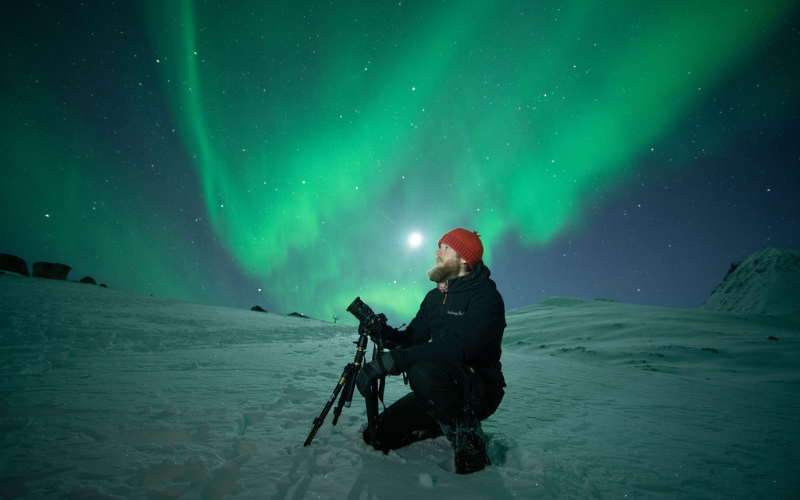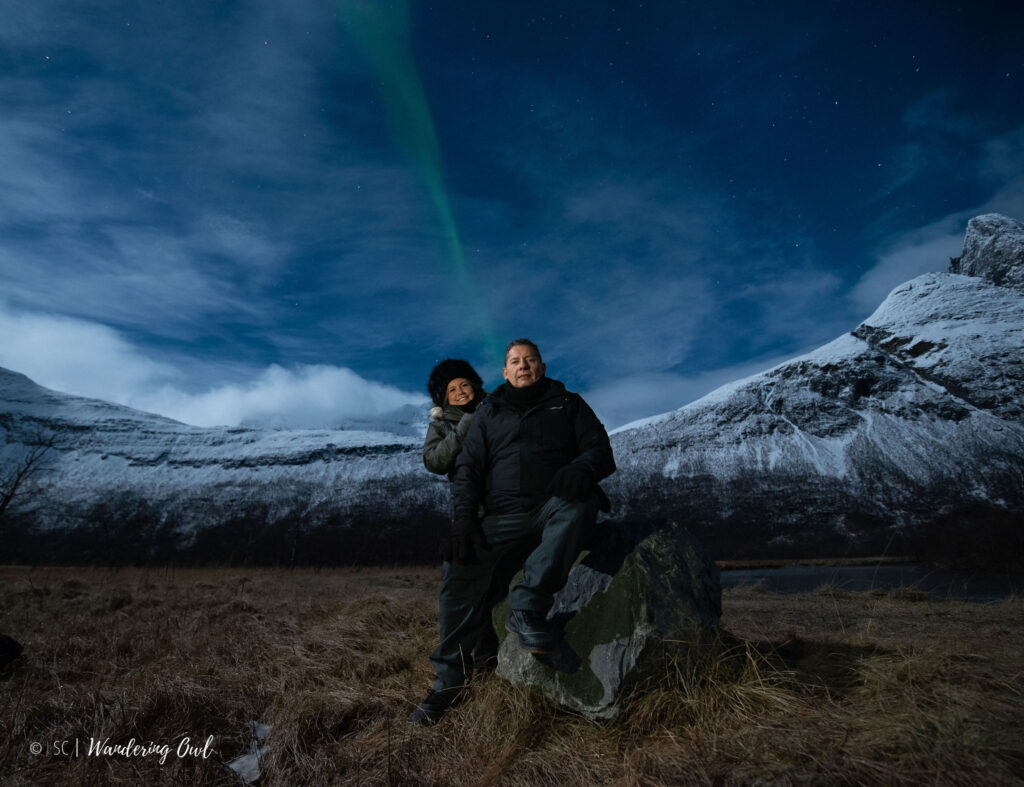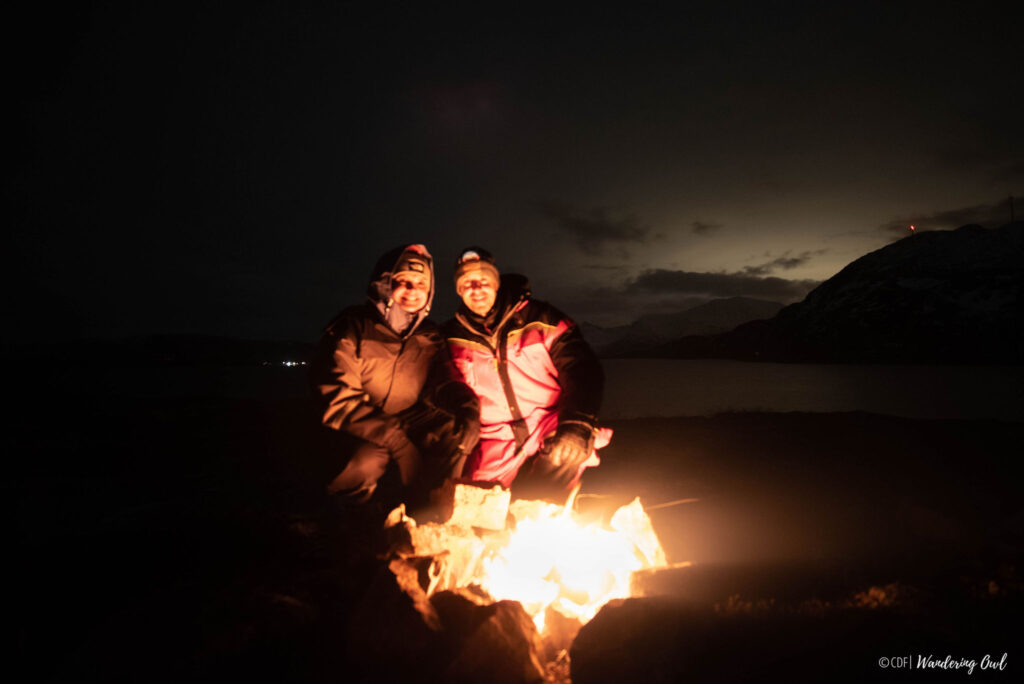Getting a good portrait during the night comes down to have the right equipment and to the guest following instructions. Wandering Owl has all the needed equipment, so it is mostly up to the guests to ensure they’re staying perfectly still for the duration the shutter is open.
A quick note – For more tips on how to get yourself as prepared as possible for your activity, please check out this article. Please remember to be sure you’ve read the information about keeping yourself warm on tour, our included food and getting to our main pick up location.

Capturing sharp photos of people at night can be challenging due to several factors associated with low-light conditions. Here are some reasons why it’s often difficult to get clear nighttime photos of people:
- Limited Available Light: At night, the availability of natural light is significantly reduced, making it challenging for the camera to capture details without introducing motion blur. The camera requires more time to gather enough light, leading to longer exposure times. Lighting up the foreground too much will make the image seem unnatural and startling, in addition, it means the sensor won’t capture other light sources well, like the Northern Lights or starry night sky.
- Handheld Camera Shake: In low-light situations, even the slightest movement of the camera (or person) can result in blurry photos. Holding the camera by hand for long exposures leads to unintentional camera shake, especially at slower shutter speeds. For this reason, Wandering Owl supplies guides with commercial grand tripods that hold the weight of the cameras and lense and are very stable. In saying this, the metal components expand and contract, which causes the tripods parts to loosen at times, making it less stable. Additionally, the Arctic wind can be crazy – and the pressure from this can push against the equipment – this is enough to make it blurry.
We do our absolute best to control what we can and mitigate what we can to prevent our equipment from being destablised. - Moving Subjects: People are often moving even when they think they’re not, making it difficult to capture sharp images. Moving subjects can introduce motion blur that can not be editing out afterwards.
Of course, the guide checks the imagine after taking it to be sure it’s sharp, however we can NEVER be 100% sure until we are back in the office and on a larger screen. We can be quite sure in the field, but never 100% sure until. This is due to the screen size and pixel limitation on the back screen of the camera itself. - Wide Aperture and Shallow Depth of Field: To gather more light in low-light conditions, photographers often use wider apertures (lower f-stop numbers). While this allows for more light, it also reduces the depth of field, making it challenging to keep both the subject and background in sharp focus.
- High ISO and Noise: Increasing the ISO setting to boost sensitivity to light can introduce noise in the image, affecting overall image quality. Balancing ISO to achieve proper exposure without compromising too much on image quality is a delicate task.
- Autofocus Challenges: Many cameras struggle with autofocus in low-light conditions. Achieving accurate focus becomes more challenging, especially when photographing moving subjects or scenes with limited contrast.
- Not enough time: Patience and cooperation are key when capturing night time photos. Understand that the photographer may need a bit more time to set up shots and adjust settings. Cooperate with any instructions provided, and trust the photographer’s expertise. In addition, there are other guests who need a photo taken the moment the lights appear. The photographer will generally hurry to get a photo of each booking quickly in case the lights disappear and once there is at least something they’ll invite groups back to take more so the photographer has more choice to choose from when they edit the photos after the tour.
- Review Samples or Portfolios: Before the shoot, review the photographer’s samples or portfolios, paying attention to their nighttime photography work. This can give you an idea of their style and competence in capturing clear images in low-light conditions.

This portrait is a great example of guests and the photographer working together to get an epic portrait. The extra challenges here that the photographer had was that there was no snow and no moonlight, making the foreground and guests difficult to light up.
To overcome these challenges and capture sharp nighttime photos of people, we implement the following techniques:
- Use a Tripod: A stable platform like a tripod eliminates camera shake, allowing for longer exposures without blurring. This is especially useful for capturing static scenes or posed portraits.
- Increase ISO Sensitivity with Caution: While higher ISO values increase sensitivity to light, they also introduce more noise. Strike a balance to avoid excessive noise while ensuring proper exposure.
- Optical Image Stabilization (OIS): If your camera or lens has optical image stabilization, activate it. OIS helps compensate for minor shakes and movements, resulting in sharper images.
- Use Faster Lenses: Lenses with wider apertures (lower f-stop numbers) allow more light to reach the camera sensor, improving the chances of capturing sharp images in low-light conditions.
- Experiment with Manual Focus: In situations where autofocus struggles, consider using manual focus. Focus on a well-lit area or use a flashlight to assist in achieving accurate focus.
- Use a shutter delay or remote: Generally the camera is on a 2 or 5 second delay so the photographer isn’t touching the camera or tripod when the shutter is open.
- Communication: Sharing this article with guests, so that they know well in advance why the guide is asking them to stand so still and to understand in advance the inherent chanllenges with capturing photos.
By understanding these challenges and implementing suitable techniques, photographers can improve their chances of capturing clear and captivating nighttime photos of people. By taking these steps and maintaining open communication with the photographer, people can increase the likelihood of getting sharp and stunning nighttime photos that capture the essence of their experience.

The combination of the dark moon and snowless night and the bright fire made this portrait especially hard. In addition, the guests have moved slightly, making it blurred on their faces.
See the full price list to our photos here: https://www.wanderingowl.com/wp-content/uploads/2024/08/Photo-pricelist-1.pdf

